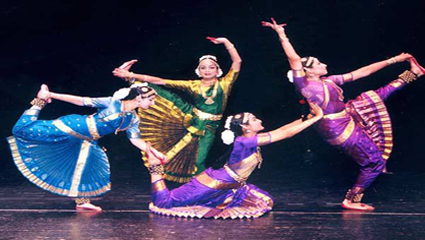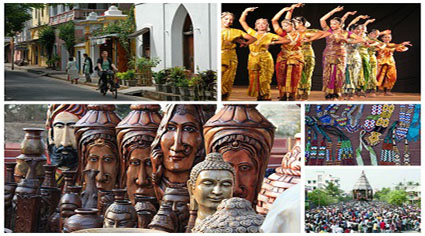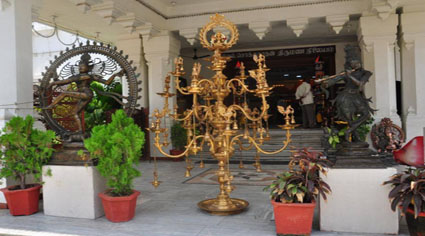Puducherry, fondly called as Puduvai by the local Tamil people, features a distinguished ancientness. Originated as a tiny
fishing village situated on the Bay of Bengal, in the south east seacoast of the country, Puducherry was a significant place for vedic teaching and learning.
Furthermore, Puducherry was the home of the Agastya (Agathiyar), one among the Saptarshis who are glorified at a lot of
places in the Vedic literature and a worshiped vedic sage and earliest Saint. The mystical liveliness of the union territory of
Puducherry obtained an imminent revival from neglect in the 20th century with the formation of Sri Aurobindo Ashram.
Some of the important fairs and festivals Puducherry include fire walking festivals, Fete De puducherry, International Yoga, Festival, Bastille Day, Sedal, Mangani Festival at Karaikal Ammaiyar Temple, Mascarade Festival, Thiraiyattam Festival at
Bhagavathi Temple, The Feast of Our Lady of Lourdes, puducherry De Jure Transfer Day, Veerampattinam Car Festival,
St.Theresa Festival, Sri Aurobindo’s Birth Anniversary, Masi Magam, Chitrai Kalai Vizha, Villianur Temple Car Festival and
other long-familiar festivals like Deepavali, Pongal, Christmas, New Year's Day, Karthigai, Bakrid, Ramzan and so on.
.
. 
|
|
The costume of the people of Pondicherry is more like those of the Tamilians in Tamil Nadu only for that of the Policemen whose costume differs. The people of Pondicherry wear traditionalIndian dresses which include pants and shirts for men and women prefer wearing saris, long skirts and blouses. On special occasions men also wear silk dhotis like the women opt for silk saris. Otherwise all the western outfits are used by the people of Pondicherry.

|
|
The music and dance forms of Pondicherry are immensely influenced by the rich heritage of the Tamil tradition. The Bhairavi is a Carnatic music circle in Pondicherry. They organize performances of Carnatic music every month. It is functioning for the last twenty two years.
Dance of Pondicherry one will get to watch performances of some of the traditional forms like Yakshgana, Kathak, Kuchipudi, Chau, Mohininattam, etc. on the occasion of Shivaratri the Chidambaram Natyanjali Festival is celebrated here every year. Performers from various corners of the country gather to perform in and attend this prestigious festival. The festival was first initiated by Kapila Vatsayan and Nagaswamy in the year of 1981.

|
|
Pondicherry food is the lifeline of the tourism. One could find here many delicious varieties of several cuisines.The non vegetarians take mutton, turtle, fish, venison and flesh of the hare. The Chettinadu recipe is one of the food items in Tamil Nadu which tops the list and makes the foreigners coming here to smack their lips. Sambhar is an unavoidable dish of the Tamils which is a must for either one of the meal in a day. Rice is a staple food of Tamil Nadu. Traditional cookware enjoys pride of place in the food of Tamilains with very good reasons. Iron vessels like karhais help to increase the level of iron in the food. Serving food in a plantain leaf especially for the guests is a traditional practice which is stillfollowed. Also being influenced by the French culture and being visited by French people frequently the cuisine of Pondicherry includes dishes like French baguettes, brioches and pastries.

|
|
One of the most ancient and rich traditions in the world is that of the Tamilians and this is also followed by the people of Pondicherry. The traditions are part their life and they also strictly adhere to it, which includes lot of rituals and ceremonies. These rich traditions of the people of Pondicherry which are deep- rooted are supposed to be quite old and have evolved over many centuries. The tradition of drawing figures at the doorstep called the "Kolam" is supposed to be a unique culture followed by the Tamils. They believe that the closed continuous figures of the kolam depicts the never ending cycle of birth and death. Attaining of puberty by girls is also celebrated as a major ceremony. Marriage is a sacrament and occupies an important place in the life of the people. The system of wearing the 'thali' or the sacred thread worn by the bride is indigenous to the southern part of the country which was incorporated by the Brahmans into their ritualistic pattern. The belief of marriage here is considered as great honour and is celebrated as a big occasion. Each community follows their own customs and tradition specific to their caste and sub caste. According to their tradition, the maternal uncle of the family plays a major role as the master of the ceremony at the time of family functions.

|
|
Just like the other states located in the southern part of the country, Puducherry too houses a majority of Dravidians. Furthermore, Puducherry is quite Indian in an identifiably distinctive manner contrary to its French background. The city finds its dance, music; arts and crafts are nothing but an extension of the rich culture of South India. In fact, the dolls made in Puducherry, fondly called as Puducherry Bommai in the local language of Tamil is world famous. Some of the important arts and crafts products of Puducherry include attractively crafted dollies and playthings made from hard unglazed brownish-red earthenware, papier-mache (substance made from paper pulp), plaster, bronze castings, kamatchi villakku, hand woven carpets, hand printed textiles, handmade paper, cane furniture, aromatic products and so on. Also, the union territory of Puducherry houses a lot of dance and music academies, arts and crafts outlets that primarily trade wooden toys, traditional musical instruments, pottery products, art prints and posters, crocheted toys, and many other products.

|
|







